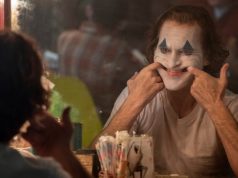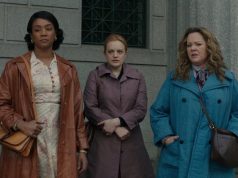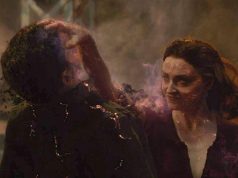Saying that “The Dark Knight” is a superhero movie based on a comic book character is like saying “The Godfather” is a crime drama based on a novel: technically accurate yet woefully inadequate.
Christopher Nolan’s new adventure, a sequel to his game-changing “Batman Begins,” is darker, more frightening, and more complex than any superhero film to date. In fact, the difference between “The Dark Knight” and its previous genre-mates is so pronounced that it’s almost useless to describe it in the usual “superhero movie” terms. Is it fun? Well, yeah — but more Martin Scorsese fun than Steven Spielberg fun. Is it exciting? Yes, certainly — but more “psychological nightmare” than “roller coaster.”
Nolan, who co-wrote the film with his brother Jonathan, with story assistance from genre veteran David S. Goyer, shot it primarily in Chicago, resulting in a Gotham that looks like a real city (with daylight and everything!), rather than the elaborate facades of the earlier films (including “Batman Begins”). This is crucial, as “The Dark Knight” explores real-world fears and real-world consequences, and those play out more effectively on the drab, ordinary streets of a real metropolis than they do on a lavishly designed sound stage.
Only a few months have passed since the events of “Batman Begins.” Bruce Wayne (Christian Bale) is living in a penthouse apartment while Wayne Manor is rebuilt, and his lifelong love Rachel Dawes (Maggie Gyllenhaal, replacing Katie Holmes) is still in the district attorney’s office. In fact, following her usual pattern, she is dating the new D.A., Harvey Dent (Aaron Eckhart), an honest man and former cop who’s being praised as Gotham’s white knight. He’s here to clean up the corruption and organized crime that have plagued the city, and that includes taking down mob boss Salvatore Maroni (Eric Roberts).
Batman has made a splash, too, albeit a more controversial one. Some praise him as a do-gooder while others say he’s a dangerous vigilante. He has inspired copycats. Gotham’s police department, now with Lt. Jim Gordon (Gary Oldman) heading up the Major Crimes Unit, officially regards Batman as a criminal for whom there is a standing arrest warrant. Unofficially, there’s that bat-logo searchlight on top of police headquarters.
Apart from the Mafia, Gotham’s newest plague is the Joker (Heath Ledger), a clown-faced lunatic with a fondness for bank robberies and a flair for the dramatic. How crazy is the Joker? Crazy enough to steal from the Maroni crime family, and then crazy enough to walk into their lair and tell them that Batman is their real problem, not him. And crazy enough to get away with it all.
Ledger’s death has certainly inspired more than its share of weepy, hyperbolic testimonials, but make no mistake: People would be buzzing about this performance even if he were still alive. He inhabits the cruel, merciless Joker in a way that’s never less than riveting, a genuinely terrifying (and fascinating) performance that instantly catapults him into the upper echelon of Hollywood’s greatest movie villains.
(But once again the ordinary terms fail us. He’s not really a “villain.” Lex Luthor is a “villain.” Jack Nicholson’s Joker was a “villain.” Ledger’s Joker is a monster, more akin to Hannibal Lecter than the Penguin, more like the evil Emperor than Darth Vader.)
Ledger’s performance is the perfect marriage of an actor unafraid to take risks — you stand a good chance of just looking silly when you do this, after all — and a screenplay that’s bold enough to paint the character not as a campy menace but as a shockingly brutal scourge of humanity. He murders as easily as he cracks jokes, and he’s sociopathic enough to not see a difference in scale between the two. I was unable to take my eyes off him whenever he was on the screen … which means my mind has a good store of visual material ready for when the nightmares come.
Nolan has packed the film with a dense storyline and multiple layers of thematic depth, all to wonderful effect. This is the first Batman movie to really address the character as a symbol, as an ideal. Batman insists he has his limits. He will not kill a criminal. He favors law and order — yet he is, technically, a criminal himself, acting outside the law and even, sometimes, outside the bounds of ethics. But the Joker, representing chaos and randomness, not to mention pure, unfiltered evil, is what throws everything off-balance. He doesn’t follow any rules whatsoever, and that separates him even from the Mafia (which is, after all, highly organized and structured).
The Joker, like the devil himself, wants everyone to delight in chaos the way he does. In his delusional mania, he believes that mankind is inherently amoral, that Joker-style anarchy is our ultimate destiny. And that’s one of the film’s questions: Is he right? Are we more like the Joker, or more like Batman, or more like the gallant Harvey Dent? And come to think of it, isn’t it Dent — who never breaks any laws and is willing to show his face to the public — who’s the real opposite of the Joker, not Batman? In some respects, Batman has more in common with the bad guys than he does with the good guys. And don’t for a moment think that this dichotomy is lost on Bruce Wayne.
The film is epic in every sense of the word, covering a dizzying array of complicated characters and moral questions while functioning as a fast-paced action flick, too. Even Wayne Enterprises CEO Lucius Fox (Morgan Freeman) and Alfred the butler (Michael Caine) are faced with quandaries that lie beyond the usual scope of their duties. Like the greatest crime dramas, “The Dark Knight” presents actions as having consequences, and consequences as requiring further action. It’s a comic-book movie with real-world applications.
There’s a point in the film where the story seems to be wrapping up, and where the running time has certainly been sufficient to call it a day. And then the film continues for another 45 minutes. This is where complaints of “it’s too long” will come into play, and at first I thought I might agree with that.
But upon further reflection, I see that it’s in this last act — the part that, story-wise, could have been fodder for the next sequel — that all the themes come together. The film could have ended earlier and felt complete, but it’s much more satisfying this way, with all the characters firmly set on the paths of their own making, and with one last Batman/Joker face-off cementing the ideas that have been on the film’s mind the whole time.
Even if this doesn’t turn out to be the best film of the year, it will almost certainly have been the most darkly thought-provoking and viscerally stimulating. The performances, while overshadowed by Ledger’s punchy brilliance, are all sharp, even when (as in the case of Rachel Dawes) the characters are underwritten. Nolan has shot “The Dark Knight” with the utmost confidence, and with a gleefully morbid sense of fun that prevents it from becoming oppressively bleak. This isn’t your grandfather’s Batman. I don’t know whose it is, but I like it.
A- (2 hrs., 32 min.; )





